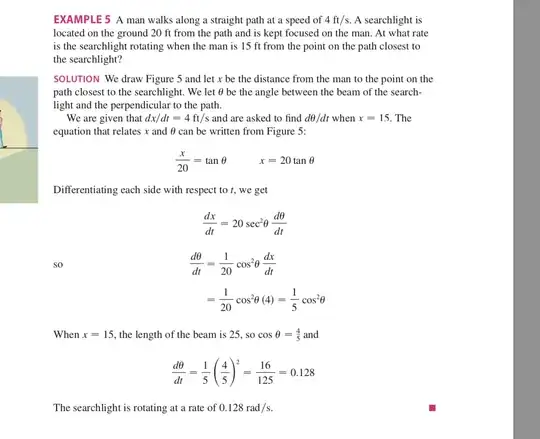I'm reading this textbook question and I'm confused as to why this answer is in radians and not degrees. How did that happen?
-
1Why shouldn't the answer be in radians? – Angina Seng Feb 20 '18 at 04:51
-
1why isn't it in degrees? – Jwan622 Feb 20 '18 at 04:51
-
@Jwan622 you are repeating yourself. – Angina Seng Feb 20 '18 at 04:54
-
@Jwan622 If you want to differentiate $\sin x$ in degrees, then you have to multiply by $\frac{\pi}{180}$ every time. Using radians makes that factor $1$ and eliminates the constant, so that the derivative of $\sin x$ is just $\cos x$. – Toby Mak Feb 20 '18 at 04:56
-
1It can be in degrees if you want, but if you insist on it being in degrees then you'll need to learn a completely different set of derivation rules. See this related question. A big part of why we prefer radians is that with the way we have rigorously defined the trigonometric functions we get nice things such as $\frac{d}{dx}[\sin(x)]=\cos(x)$ when $x$ was treated as being in radians while we have instead $\frac{d}{dx}[\sin(x^\circ)]=\frac{\pi}{180}\cos(x^\circ)$ if in degrees. – JMoravitz Feb 20 '18 at 04:57
2 Answers
If the question is about "why we use radians instead of degrees in calculus", look at following thread: Why do we require radians in calculus?
- 491
The set of trig differentiation rules pretty much everyone uses is for the radians version of the trig functions. We use radians because they make the differentiation and integration of trig functions come out without ugly constants.
You could write a set of differentiation rules for "trig function in degrees" but then every rule contains an ugly extra constant. We can derive the degrees rule by applying the shortcut chain rule* to the corresponding radians rule. For example for than tan function (using $_{deg}$ for the degrees version of a trig function and $_{rad}$ for the radians version of a trig function).
$$\frac{d}{dx}\tan_{deg}{x} = \frac{d}{dx}\tan_{rad}\left({\frac{\pi}{180}x}\right) = \frac{\pi}{180}\sec_{rad}^2\left({\frac{\pi}{180}x}\right)= \frac{\pi}{180}\sec_{deg}^2x$$
But altogether it's easier to do trig calculus with radians and if necessary convert to degrees after all the calculus work is over.
* differentiate with respect to the bracket, then multiply by the derivative of the inside of the bracket.
- 1,256
